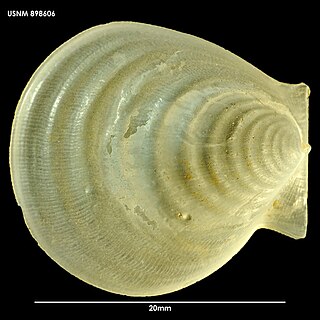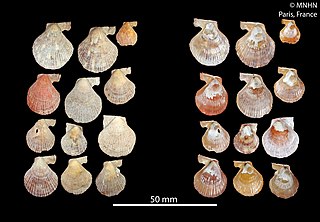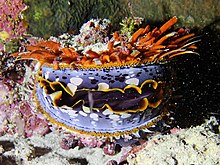
Bivalvia or bivalves, in previous centuries referred to as the Lamellibranchiata and Pelecypoda, is a class of aquatic molluscs that have laterally compressed soft bodies enclosed by a calcified exoskeleton consisting of a hinged pair of half-shells known as valves. As a group, bivalves have no head and lack some typical molluscan organs such as the radula and the odontophore. Their gills have evolved into ctenidia, specialised organs for feeding and breathing.

Scallop is a common name that encompasses various species of marine bivalve mollusks in the taxonomic family Pectinidae, the scallops. However, the common name "scallop" is also sometimes applied to species in other closely related families within the superfamily Pectinoidea, which also includes the thorny oysters.

The Pteriomorphia comprise a subclass of saltwater clams, marine bivalve molluscs. It contains several major orders, including the Arcida, Ostreida, Pectinida, Limida, Mytilida, and Pteriida. It also contains some extinct and probably basal families, such as the Evyanidae, Colpomyidae, Bakevelliidae, Cassianellidae, and Lithiotidae.

Placunidae, also known as windowpane oysters, windowpane shells, and Capiz shells, are a taxonomic family of saltwater clams, marine bivalve mollusks which are related to oysters and scallops.

Isognomonidae is a family of medium-sized to large saltwater clams. They are pearl oysters, marine bivalve molluscs in the superfamily Pterioidea

Chlamys is a genus of small scallops, marine bivalve molluscs in the family Pectinidae. The name is taken from the Ancient Greek, χλαμΰς or Chlamys, a cloak worn by soldiers.

Talochlamys zelandiae, common name the fan shell, is a species of marine bivalve mollusc in the scallop family Pectinidae.

Hyalopecten is a genus of marine bivalve molluscs.

Pectinida is a taxonomic order of large and medium-sized saltwater clams, marine bivalve molluscs, commonly known as scallops and their allies. It is believed that they began evolutionarily in the late Middle Ordovician epoch; many species, of course, are still extant.

Propeamussium is a genus of saltwater clams, marine bivalve mollusks in the order Ostreoida.
Spondylus ostreoides is a species of spiny oyster. It was only found once, off Raoul Island in the South Pacific Ocean.

Ylistrum balloti, known as Ballot's saucer scallop is found around the waters of Australia. This scallop may live for a maximum of four years, and reach 14 cm in shell length, though more commonly 8 to 9 cm. Well regarded as seafood in Asia and Australia.

Cyclochlamydidae is a family of bivalves belonging to the order Pectinida.

Pedum is a monotypic genus of bivalves belonging to the family Pectinidae. The only species is Pedum spondyloideum and it is the only genus in the tribe Pedini.

Talochlamys is a genus of bivalves belonging to th subfamily Pedinae of thee family Pectinidae.

Scaeochlamys is a genus of marine bivalves belonging to subfamily Pedinae of the family Pectinidae.

Semipallium is a genus of bivalves belonging to subfamily Pedinae of the family Pectinidae.

Spathochlamys is a genus of scallops, marine bivalve molluscs in the taxonomic subfamily Pedinae of the family Pectinidae.
Grippina is a genus of bivalves in the family Spheniopsidae which currently consists of nine species. It was first described by William Dall in 1912 with G. californica recorded in the eastern Pacific Ocean near California, US. Their habitat spans across the Pacific Ocean, mainly centering around Australia and New Zealand, though G. coronata was found in 2015 off the coast of Rio de Janeiro, Brazil in the western Atlantic Ocean. Bivalves in the genus Grippina are part of the order Anomalodesmata, also known as septibranchs, which are carnivorous clams. They use their inhalant siphons, adapted with sensory papillae to detect motion, to inhale microscopic crustaceans such as ostracods. As sessile, benthic predators, they lie in wait under sand and stick their siphons out into open water to feed. Their shells range in size from about 2–5 millimeters.















